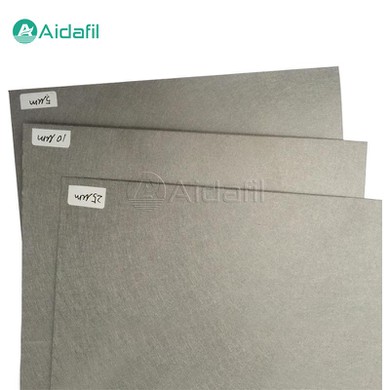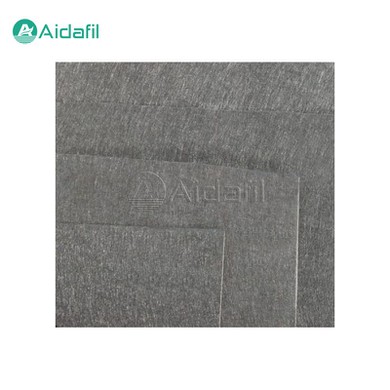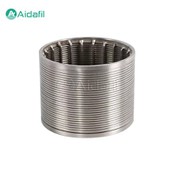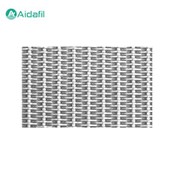
Large Capacity Stainless Steel Fiber Sintered Felt
Product Details
The large capacity stainless steel fiber sintered felt is a new type of porous material made of stainless steel fiber through grinding, lamination and high-temperature diffusion bonding (sintering). It has excellent strength and filtration function, mainly manifested in its high porosity, uniformly distributed pore size and large dirt holding capacity.
Physical properties
1. High porosity
The porosity of large capacity stainless steel fiber sintered felt can reach more than 80%, which makes it have a larger effective filtration area under the same volume, which helps to improve the filtration efficiency.
2. Controllable pore size
In production, the pore size can be controlled by adjusting the fiber diameter, laying density and sintering conditions to meet the needs of different filtration precisions.
3. Good permeability
Due to its unique pore structure, the fluid can pass quickly, reducing the pressure drop and increasing the processing capacity.
4. Excellent corrosion resistance
The stainless steel material gives the sintered felt good corrosion resistance and can be used in a variety of complex chemical environments.
Mechanical properties
1. High strength and durability
The fiber nodes in the sintered felt are firmly combined, which makes it have high tensile strength and durability, and can work stably in harsh environments.
2. Thermal stability
It has outstanding high temperature resistance and can be used for a long time in an environment up to about 600°C without deformation, which is suitable for high temperature filtration occasions.
3. Processability
Although it has high mechanical strength, stainless steel fiber sintered felt can still be post-processed by cutting, folding, stamping, etc. to adapt to different filter designs.
Parameters
|
Model |
Filter precision (μm) |
Bubbling point pressure (pa) |
Air permeability (L/min, dm2, kpa) |
Porosity (%) |
Containment capacity (mg/cm2) |
Thickness (mm) |
Fracture strength (Mpa) |
|
Basic value |
Basic value |
Basic value |
Basic value |
Basic value |
Basic value |
||
|
ADZB-5 |
5 |
6800 |
47 |
75 |
5 |
0.3 |
32 |
|
ADZB-7 |
7 |
5200 |
63 |
76 |
6.5 |
0.3 |
36 |
|
ADZB-10 |
10 |
3700 |
105 |
75 |
7.8 |
0.37 |
32 |
|
ADZB-15 |
15 |
2450 |
205 |
79 |
8.6 |
0.4 |
23 |
|
ADZB-20 |
20 |
1900 |
280 |
80 |
15.5 |
0.48 |
23 |
|
ADZB-25 |
25 |
1550 |
355 |
80 |
19 |
0.62 |
20 |
|
ADZB-30 |
30 |
1200 |
520 |
80 |
26 |
0.63 |
23 |
|
ADZB-40 |
40 |
950 |
670 |
78 |
29 |
0.68 |
26 |
|
ADZB-60 |
60 |
630 |
1300 |
85 |
36 |
0.62 |
28 |
|
Deviation of 10% |
Deviation of 10% |
Deviation of 10% |
Deviation of 10% |
Deviation of 10% |
Deviation of 10% |
Deviation of 10% |
Application areas
1. Chemical liquid filtration
In the chemical production process, it can be used to filter impurities in raw materials, intermediate products or final products, such as catalyst removal, polymer filtration, etc.
2. Gas dust removal
It is used for high-temperature flue gas dust removal, such as coal-fired power plants, metal smelting, cement manufacturing and other industries, to effectively remove particulate matter in the exhaust flue gas.
3. Food and pharmaceutical industry
In the food and pharmaceutical industries, it is used to ensure the purity and safety of liquids and meet strict hygiene standards.
Manufacturing process
1. Raw material preparation
First, it is necessary to select stainless steel fibers of suitable wire diameter and length. These fibers are usually made of high-quality stainless steel materials such as 304 or 316L, with good corrosion resistance and mechanical strength.
2. Dispersion treatment
The stainless steel fibers need to be fully dispersed to ensure that the fibers can be evenly distributed during the subsequent laying process. This step has a decisive influence on the porosity and strength of the final product.
3. Laying and forming
The dispersed fibers are laid into a uniform mesh structure through special equipment. At this stage, the density of the fibers and the thickness of the mesh can be adjusted according to needs.
4. Sintering process
The laid mesh structure is sent to a high-temperature furnace for sintering. Under precisely controlled temperature and atmosphere, the fibers are diffused and bonded to form firm nodes, thereby producing a stable pore structure.
Maintenance and regeneration
1. Cleaning methods
Regular cleaning can effectively extend the service life of sintered felt. Depending on the pollutants, ultrasonic cleaning, chemical cleaning and other methods can be used.
2. Regeneration treatment
For severely clogged sintered felt, heat treatment or chemical treatment can be performed to restore some of its filtration capacity.
3. Storage and maintenance
When not in use, it should be stored in a dry and clean environment to avoid contact with corrosive substances and prevent mechanical damage.
Why Choose Us
· Professional manufacturer with many years' experience
· Good quality with competitive price
· OEM & ODM are welcome
· Various payment items are acceptable
· Good service by experienced manager
AIDA Philosophy
1. Management Concept:
· Satisfy the customers' demand --- Touch customers, trust with our products and services
· Make employees happy --- Pursue higher material and spiritual happiness
2. Company Mission:
· Focus on customer needs, provide best filtering solution
· To be the lifelong partner with customers
3. Corporate Vision:
· Become a global purification leadership brand
4. Values:
· Customer: Pursue the ultimate experience, enjoy excellent quality
· Team: Trust, responsibility, growth, win-win
· Work: Simple, sincere, efficient, dedicated
Hot Tags: large capacity stainless steel fiber sintered felt, China, factory, price, buy, reliable metal sintered felt, high precision transformer oil filter cartridge, high precision automatic self cleaning filter, Self cleaning Screen Filter, 10 micron machine oil filter, high filtration efficiency duplex basket strainer








